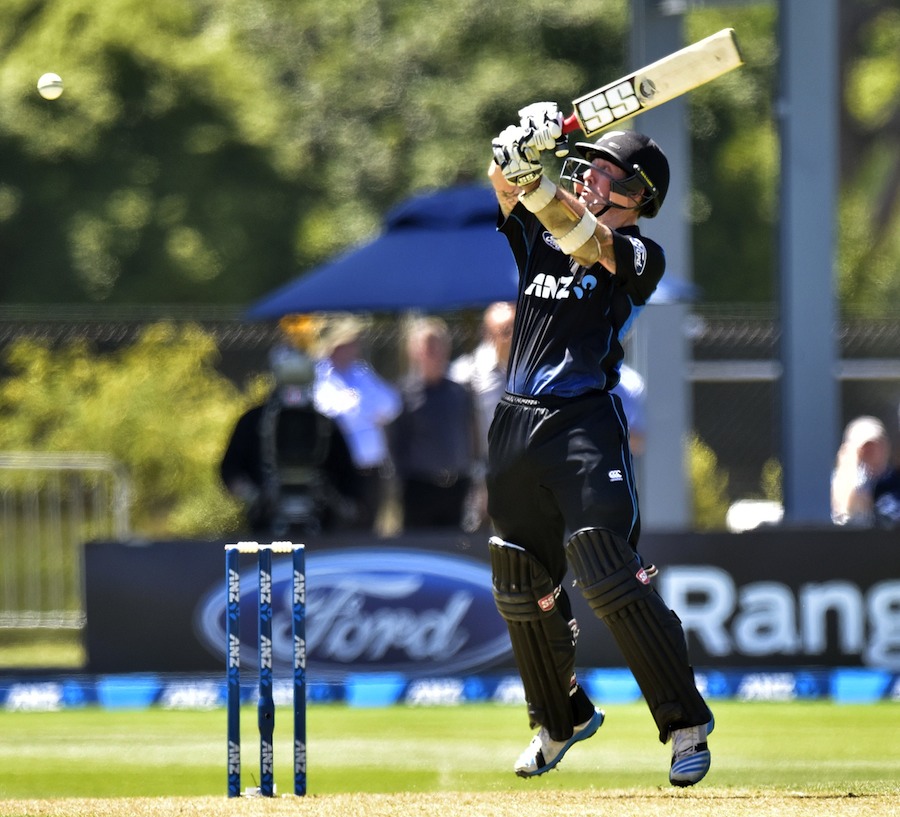A record-shattering sixth-wicket stand between Luke Ronchi and Grant Elliott yanked New Zealand out of the mire at 93 for 5 and sent them hurtling to 360 for 5, in what began as a counterattack and then grew into a gargantuan, unstoppable thing of terror. Their unbeaten stand of 267 off 180 balls was the highest ever for the sixth wicket, and is the second for any wicket for New Zealand.
In response, Sri Lanka managed 15 fewer runs than Ronchi and Elliot did together, and were 108 shy of the hosts’ total, despite a spirited 116 from 106 balls for Tillakaratne Dilshan.
Ronchi was chief architect of the mauling, clobbering 170 from 99 balls, murdering anything pitched up and never failing to slam the short balls over the leg-side fence. Rarely did he fail to execute the strokes he attempted, no matter how audacious. His maiden ton was scored from 74 balls. The next 70 runs were slammed off 25. He hit nine sixes and 14 fours in all.
Elliott was slightly more reserved in the early phase of their partnership but once he had set himself a foundation with 25 runs off 35 balls, his strike rate moved smoothly upwards, even if he sought to give Ronchi more of the bowling. By the end of the innings, Elliott was creaming the dross Sri Lanka served up at the death almost as cleanly as his partner was. His 104 not out came from 96 deliveries; he then returned with the ball to deliver nine pinpoint overs that conceded only 44 and claimed two wickets.
Sri Lanka were indisciplined with the ball to begin with, despite the seam movement on offer, but became truly pathetic by the end of the innings. Suranga Lakmal missed his lengths more often than he hit them towards the death, traveling for 93 in his 10 overs. Nuwan Kulasekara nabbed two wickets with the new ball, but was almost as bad with the older one. He disappeared for 73 from his full quota.
Lasith Malinga’s absence was keenly felt at the death, but Angelo Mathews was also missing, thanks to a calf niggle. Acting captain Lahiru Thirimanne took two wickets with his seam-up deliveries, but was otherwise disappointing in the field, shelling difficult chances off Ronchi and Elliott once each. Elliott was 47 when the diving chance at short cover went down. Ronchi was already at 167 when the overhead chance, running back from point, was spilled in the last over.
Ronchi began his charge with two of the simplest sixes he will ever hit. Jeevan Mendis dropped the ball halfway down the pitch on successive deliveries, and was walloped over cow corner in the 25th over. The boundaries were scored almost at will from then on.
Sachithra Senanayake’s introduction to the attack had been delayed slightly, thanks to the earlier success of the seamers, but he was picked off effortlessly by Ronchi and Elliott, who used the sweep to excellent effect against his leg-stump line. They occasionally came down the pitch to the spinners, but were largely content to punish the bad balls – of which there were many – from the crease.
Ronchi and Elliott strolled past their individual half-centuries, and by the 40th over, had catapulted New Zealand to 238 for 5. The last seven overs were a blur of boundaries as Sri Lanka failed emphatically to execute a wide-yorker plan, their quicks routinely delivering knee-high full tosses that the batsmen hammered down the ground or slapped to the off-side fence. The pair struck 122 runs from the last 10 overs to complete one of the most emphatic lower-order comebacks in a tour brimming with them.
That Sri Lanka allowed themselves to slip to such a woeful position will now be a source of extreme frustration in the dressing room. At 20 overs, New Zealand were 93 for 5. The visitors perhaps hoped to keep the opposition to 175 at that stage. They ended up getting twice that amount, and Sri Lanka did not get another breakthrough. They were repeatedly thwarted by mammoth lower-middle order partnerships in the Tests, and each of the ODIs they have lost so far has featured substantial stands for the fifth, sixth and seventh wickets.
Thirimanne and Dilshan sunk balls into getting in and setting a foundation in the chase, making clear Sri Lanka’s plan to conserve wickets and attack in the latter half of the innings. There were flashes of aggression in the mandatory Powerplay, like in the ninth over when Thirimanne pulled Tim Southee for four then picked him up to deposit him in the bleachers beyond wide long-on next ball. The New Zealand bowlers were more accurate than the opposition had been, however, and fewer loose balls abounded. Thirimanne eventually fell for 45 off 65 balls, pulling a gentle Elliott half-tracker to fine leg, immediately after a drinks break.
Sri Lanka perhaps had a glimmer of hope while Dilshan was at the crease. Kumar Sangakkara and Mahela Jayawardene were not at their fluent best, particularly on such a flat batting strip, but Dilshan scythed his way through the innings at close to a run a ball, and had Sri Lanka requiring 192 runs from the last 20 overs, with eight wickets still in hand.
He reached his 20th ODI ton – and his third in the last five innings – off 95 balls, before Sri Lanka were again scuppered by the batting Powerplay. Jayawardene was dropped by a backpedalling Taylor at fine leg on 25, but was out next over anyway, letting a Trent Boult yorker bowl him through his legs as he attempted to scoop it over his shoulder. When Dilshan fell miscuing one to mid-off three balls later, Sri Lanka were effectively beaten. The last eight wickets tumbled within eight overs, and the visitors were bowled out for 252, with more than six overs still to play.
(ESPNcricinfo)



